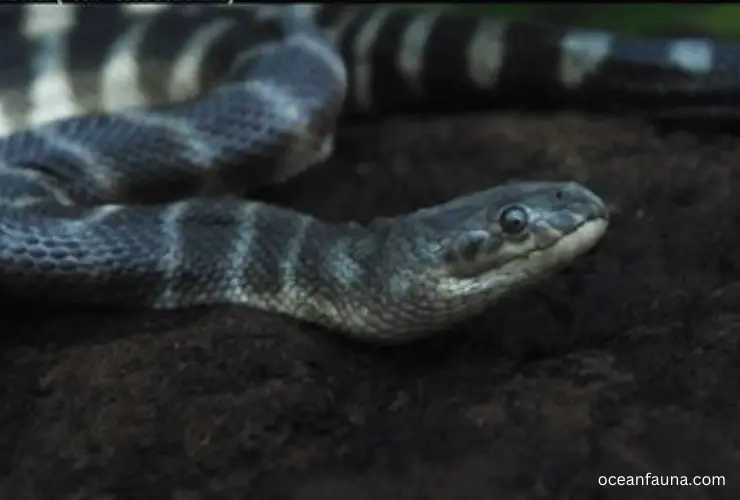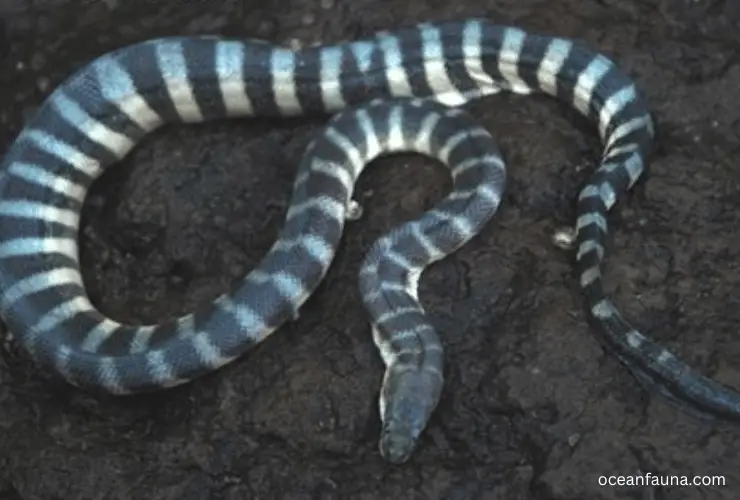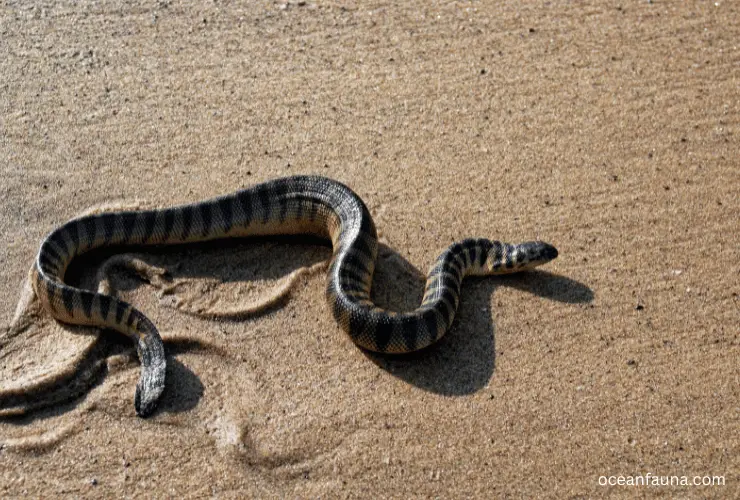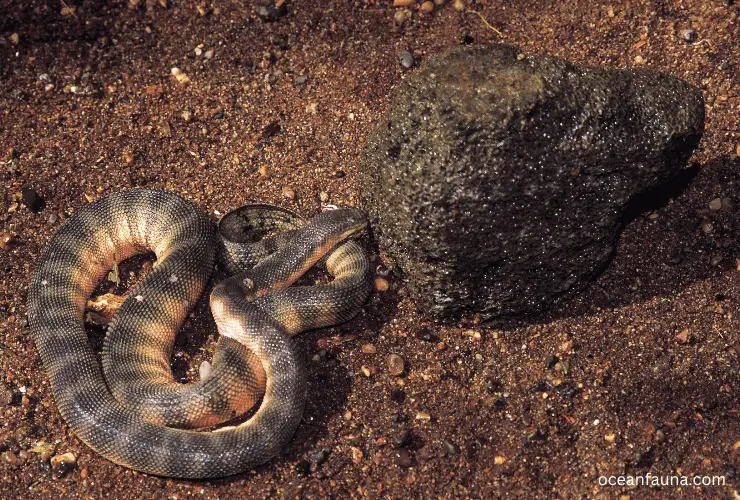Hook-Nosed Sea Snakes – poisonous reptiles that can easily be recognized by their appearances. That’s the reason they are also called beaked sea snakes. Because there are some facts and figures that are associated with them to identify these sea creatures as distinct types of snakes.
One of the most unique things about hook-nosed sea snakes is they are venomous and live in the water. They enjoy living and hunting in the deep oceans. Seas are their homes, and they are cold-blooded. They rely on their surroundings to regulate their body temperature.
These marine creatures have a lot of facts associated with them. And we know our audience is anxiously waiting to uncover every question related to the hook-nosed sea snakes. So, wait no further. Let’s discuss these sea beasts and answer every query related to them.
About Hook-Nosed Sea Snake: Facts and Features
Kingdom: Animalia
Phylum: Chordata
Class: Reptilia
Order: Squamata
Suborder: Serpentes
Family: Elapidae
Genus: Enhydrina
Species: E. schistosa
Binomial name: Enhydrina schistosa
Synonyms: Hydrophis schistosus
Size: 3 to 5 feet
Lifespan: approximately 15 years
Endangered Status: least concern
Location: oceans
Diet: carnivore
Hook-Nosed Sea Snake Habits and Lifestyle
Every snake has a different lifestyle, unique habits, and distinct living standards. So, hook-nosed sea snakes also have a great appetite and interesting sea life. Let’s discover it here.
1. Appearance and Physical Characteristics
Some of these sea snakes are small in size, while others are moderate. Their standardized length is between 3 feet to 5 feet. The weight of an adult hook-nosed sea snake is up to 4 pounds or even less than this.

The top body part of this snake is gray, while the lower body parts are white. Their bodies have a unique feature in subtle grayish-blue barring. The heads of beaked sea snakes are angular, just like a look and have sharp features and narrow physiques.
These are called hook-nosed sea snakes due to their nose. Yes, the nose is the key feature behind the key characteristics of their physique. Their heads slope forward towards their mouth or beak. That’s why they are hook-nosed or beaked sea snakes.
What about the tail? How can we forget to discuss the main feature of this beast? The tail is their primary body feature. It has outlines that are reminiscent of oars. This oar-like tail helps them to navigate their sea sites easily and move and swim quickly.
So, how will you identify a hook-nosed sea snake? The following points could be a great help to you:
- Gray upper body
- White lower body and pale-yellow sides
- Blue-gray bars
- If juvenile, it will be olive or gray with black bands, the widest ones being in the middle
- Length of head + body = 1110mm or 3-5ft
- The tail measures 190mm
- Weight is 4 lbs or less
- Larger scales on the top of its head
2. Diet and Nutrition of Hook-Nosed Sea Snake
The hook-nosed sea snake’s primary food sources are shrimp and catfish. They use their sense of smell or touch to locate potential food sources. Once their prey stops struggling, they devour it.
That way, they can enjoy their discoveries from the most important parts first. Thus, they fulfill their nutrition needs from fish, balloons, or species of smaller fish and squid. They are “carnivore-eaters”. Typically, they do most of their meals at night.
“They use an unconventional method of hunting in which they touch and detect their prey’s movement rather than relying on their eyesight. As a result, they can hunt and eat even when it’s dark out.”
“At 30 degrees Celsius, the sea snake is at its most digestible. The snake’s digestive enzymes can digest almost anything, including meat, fat, and organs, except bones. With its closed circulatory system, the snake can efficiently transport the nutrients to all parts of its body.” (Source)
3. Development Cycle
It is common knowledge that this snake lays its eggs in the ground between September and October, from which anywhere from 18 to 30 babies emerge.
The species has a high death rate and a fast reproduction rate. At 18 months, they are considered mature, and by 24 months, females can begin reproducing.
4. Reproductive System
Since the male and female of this species of snake have separate genitalia for reproduction, we call them dioecious. In most cases, the mating season for beaked sea snakes is during September and October.
Their eggs are fertilized inside the female. The lengthy process of reproduction necessitates several trips to the surface for air. The kids born to these women are healthy and relatively large.
Thus, we classify them as viviparous. They have the highest reproductive rate of any marine snake, producing up to 30 offspring per birth on average. A typical newborn weighs roughly 11.4 grams.
According to the research,
“The species has a high death rate and a fast reproduction rate. At 18 months, they are considered mature, and by 24 months, females are able to begin reproducing.” (Source)
5. Habitat Analysis
As its popular name suggests, the beaked sea snake prefers to spend its time in the water. They populate coastal lagoons and the shallow open seas. Estuary settings of sand and mud are hampered by this species.
They have also been spotted in harbors and shallow bays. They are not restricted to saltwater habitats but have been discovered in river mouths, swimming up rivers, and huge lakes as well.
Over mud flats and other muddy areas, they can be found in aquatic habitats. They occasionally travel onto dry land near mangrove forests, but they never go very far. The optimal depth for them is between five and thirty meters.
6. Behavior Analysis
When sea snakes are in the midst of their winter mating season, they can become rather hostile and aggressive. When startled or threatened, they may bite.
Also, if you accidentally capture them in nets, they become aggressive and try to bite. They are not friendly. All things long, especially high-pressure hoses, capture their attention.
Another research revealed the following behavior facts,
“If one of these snakes bites you, you should expect the effects to be so severe that it will kill 50 people.” (Source).
7. Predators of Enhydrina schistosa
One thing is definite humans are one of the biggest predators of Enhydrina schistose or Hook-Nosed Sea Snakes. We have not found any natural predator of this snake other than humans.
It is hunted for skin, meat, and organs and for creating antivenom for snake bites in many countries. There are antivenom factories in Thailand for which they are being collected in huge numbers. What other predators do you think are haunting these reptiles?
Where Do Hook-Nosed Sea Snakes Live?
Bioweb.uwlax.edu’s page from multipleorganisms.net has discussed the locations where hook-nosed sea snakes were spotted. Check the following statements:
“As a result of its widespread distribution, the hook-nosed sea snake is an everyday sight in its native habitats. They can be found all over the northern and eastern Indian Ocean, Papua New Guinea, and the Arabian Gulf and Gulf of Oman. Coastal areas of the Malaysian Peninsula are teeming with them, while Australian waters are typically devoid of them.” (Source)
According to Animalia’s research, this sea snake species is in the Indo-Pacific region vast majority. It has caused more than 50 % of snake bites and caused a large number of envenoming and deaths. (Source)
“Hook-Nosed sea snakes live on the coasts and coastal islands of United Arab Emirates (UAE), Saudi Arabia, Qatar, Oman, Kuwait, Iraq, Iran, and Bahrain, south of Madagascar and Seychelles, the Pakistani and Indian coasts from Gujarat to West Bengal, and Andaman & Nicobar Island, Sri Lanka, Bangladesh, Indonesia, Malaysia, Philippines, Singapore, Myanmar, Thailand, Vietnam, Cambodia, and China.”
What Is the Scientific Name for Hook-Nosed Sea Snakes?
Beaked sea snake, Valakadeyan sea snake, common sea snake, and hook-nosed sea snake are their common names. However, the scientific name of this snake is Enhydrina schistosa. These snakes are counted as the world’s most dangerous reptiles.

This is why it belongs to the class of reptilia and the family of Elapidae. This class and family consist of one of the most venomous sea snakes (including both tropical and subtropical) that have erect fangs. The order of hook-nosed sea snakes is Squamata of the snakes, lizards, and scaled reptiles.
It belongs to the genus “Enhydrina”, which also includes other highly poisonous sea snakes like the Enhydrina Zweifel, also known as the Sepik or Zweifel’s beaked sea snake. It does not have any subspecies. The Malayalam and Tamil word Vala kadiyan, which means “net biter,” is whence the name Valakadeyan originates.
Different Types of Hook-Nosed Sea Snakes
Hook-nosed sea snakes do not have any sub-specie and that’s why we cannot specify their types from subspecies. However, it lives in different areas and its types are recognized by where it lives and what it eats.
Most commonly, it lives in New Guinea and Australia. So, this is one of its types. It inhabits the same environments as the other species, including estuaries, river mouths, rivers mouths, and shallow open seas with mangrove forests.
That’s why it’s called a common sea snake. (There are two species of Hook-Nosed Sea Snakes that we have discussed in the Facts section)
What Is the Population Status of The Hook-Nosed Sea Snake?
According to Animalia’s research,
“According to the International Union for Conservation of Nature (IUCN), the Beaked sea snake is abundant across its range, although there is no overall population estimate available.
This species is currently considered to be of “Least Concern” (LC) by the IUCN Red List, and its population is thought to be steady at present.” (Source)

Thus, “Least Concern” is the rating given to it by the IUCN Red List. Juvenile population estimates in 1985 in the Muar river estuary in Malaysia ranged from 900 to 1,400, with adult population estimates at 1,344 654. Because of the tropical estuary’s favorable climate, juveniles gained about half a gram in weight every day.
Is Hook-Nosed Sea Snake Venomous?
One of the uncool facts about hook-nosed sea snakes is they are venomous. Its poison has outweighed the poison of all other sea snake species. Let’s see how?
“The great majority of sea snake fatalities are caused by beaked sea snakes. According to research, its venom is four to eight times as deadly as that of a cobra. The toxicological data show that their LD50 is 0.1125 mg/kg.
There is 7.9 to 9.0 mg in every meal; however, just around 1.5 mg is needed to kill a human. This means that this snake is among the most dangerous and venomous in the world.” (Source)
How Venomous Is the Hook-Nosed Sea Snake?
Kingsley Ozongwu has described it as one of the deadliest snakes in the world.
“This marine snake is infamous for being extremely dangerous and venomous. Without antivenin, a bite from this organism will quickly and painfully end your life, therefore you definitely don’t want to get into contact with it.” (Source)
What Are the Symptoms Of The Hook-Nosed Sea Snake Bite?
The most common signs of the Hook-Nosed Sea Snake bite are given below:
- Ptosis
- Dysphagia
- Non-Rigid paralysis
- Swelling and redness
- Bruising
- Bleeding
- Blistering around the wound
- Shortness of breath
- Seizure or sudden collapse
These symptoms occur within 30 minutes to 2 hours after the bite of the snake. However, there are more severe signs of envenomation of these snakes. Some of these includes:
- Sudden death
- Heart failure
- Kidney failure
- Paralysis
- Respiratory collapse
Hook-Nosed sea snake bite is common, and their outcomes are more dangerous than any other snake bite. Immediate medication and antivenom are required for the safety of life.
Is There Any Antivenom for The Bite of A Hook-Nosed Sea Snake?
Yes, there are antivenoms for the bite of a hook-nosed sea snake or Enhydrina schistosa. These are not specific but helpful in many cases of bites from these sea snakes.
According to NCBI research, there is an antivenom for this dangerous species.
“The ultimate treatment for a sea snake envenomation is Australian CSL sea snake antivenom, however, it is prohibitively expensive and thus not commonly available or well supplied in local hospitals.” (Source)
So what other antivenoms are beneficial for a common sea snake to bite? This NCBI research has also suggested three other antivenoms as an antidote for the treatment of Enhydrina schistosa’s bite. These includes:
- Taiwan bivalent antivenom
- Thai monocled cobra monovalent antivenom
- Thai neuro polyvalent antivenom (NPAV)
Fascinating Facts About Hook-Nosed Sea Snake
Here are a few amazing and fascinating facts related to this hook-nosed sea snake:
- Hook-nosed sea snakes do not belong to one species. There are two species of these snakes. Due to convergent evolution, both species look similar, but they are different.
- The hook-nosed sea snakes are venomous, not poisonous. Both words are used interchangeably, but they are different. Furthermore, these snakes are the most deadly and venomous creatures all over the world.
- Venom from these snakes contains a wide variety of chemicals and proteins. Their venoms are made from extremely intricate combinations of chemicals and proteins. All of these components are necessary for the venom to be deadly, but they all contribute in their unique way.
- The Elapidae family includes snakes like the cobra and krait that have neurotoxic venom.
- When it comes to dangerous reptiles, sea snakes take the cake.
- Its salt-secreting glands help it get rid of any unnecessary sodium.
- A bite from this snake requires emergency medical care for the victim.
FAQs
Is the beaked sea snake the most venomous snake?
Yes. It is one of the top 10 most venomous snakes in the world, and its venom is said to be 100 times more dangerous than the venom of any other snake. You can imagine how dangerous it is. It’s also said that hook-nosed sea snakes are as dangerous as cobras.
Is the beaked sea snake aggressive?
Yes, the beaked sea snake or hook-nosed sea snake is an aggressive creature like other sea snakes. It is most belligerent during the winter months when it is mating season. Aside from that, it will only bite in the act of self-defense or when it is startled.
Is Enhydrina poisonous?
No, it is venomous. If you think it’s poison from its venomous bites, then it’s called poisonous. On the other hand, poisonous denotes that it contains a toxin that can be consumed or inhaled. When injected, its venom can be dangerous, although swallowing most snake venom is not likely to put a person in danger.
How do beaked sea snakes hunt?
They hunt while hiding in coral reefs and they hunt alone. Although sometimes they hunt in groups on the catfish or fish, usually they hunt alone. They bite their prey and paralyze them and wait until it stops moving. These sea creatures then swallow the whole thing and digest the food for nutrition.
What are the main threats to hook-nosed sea snakes?
Pollution, becoming entangled in fishing nets, and being taken for their venom and skins are the primary dangers faced by hook-nosed sea snakes. People also kill them when they see them while they feel insecure or threatened. This is another threat to hook-nosed sea snakes.
Conclusion
Hook-Nosed sea snakes are undoubtedly one of the most venomous sea snakes on this globe. I hope you find the above-mentioned specific facts interesting and incredible. If you have any queries, you can ask. We would love to answer your questions.
Cheers!


1 thought on “Cool Facts About Hook-Nosed Sea Snake”